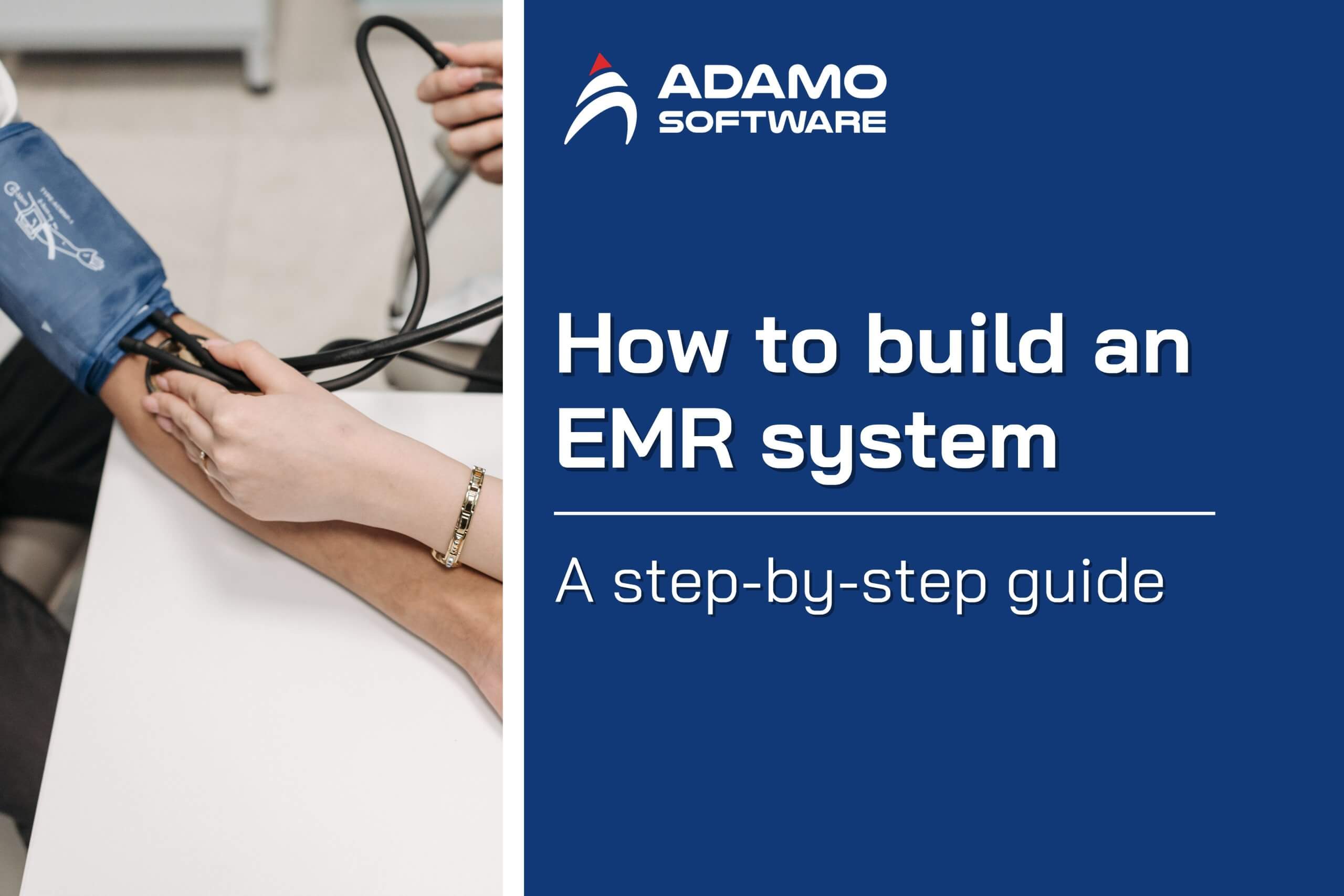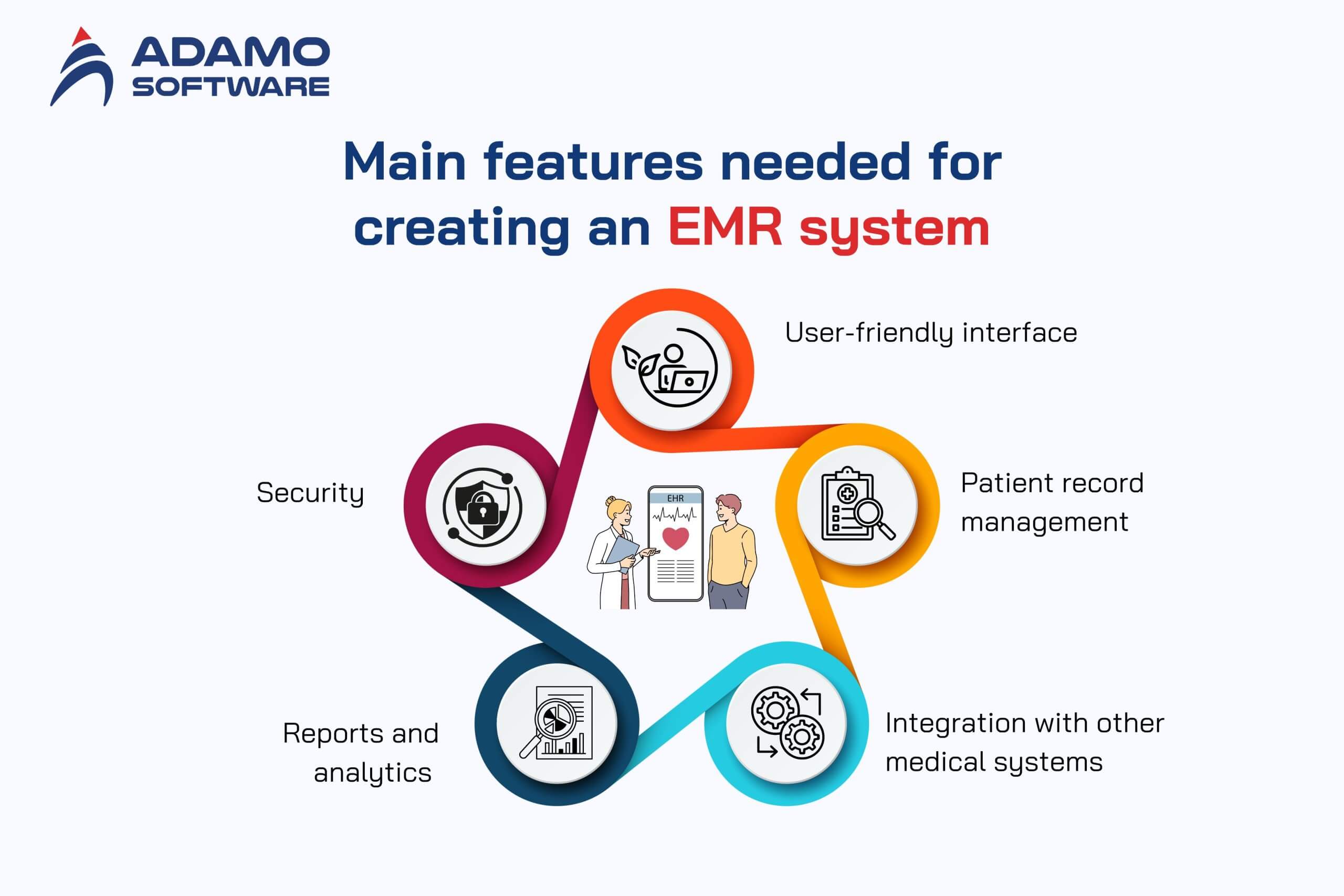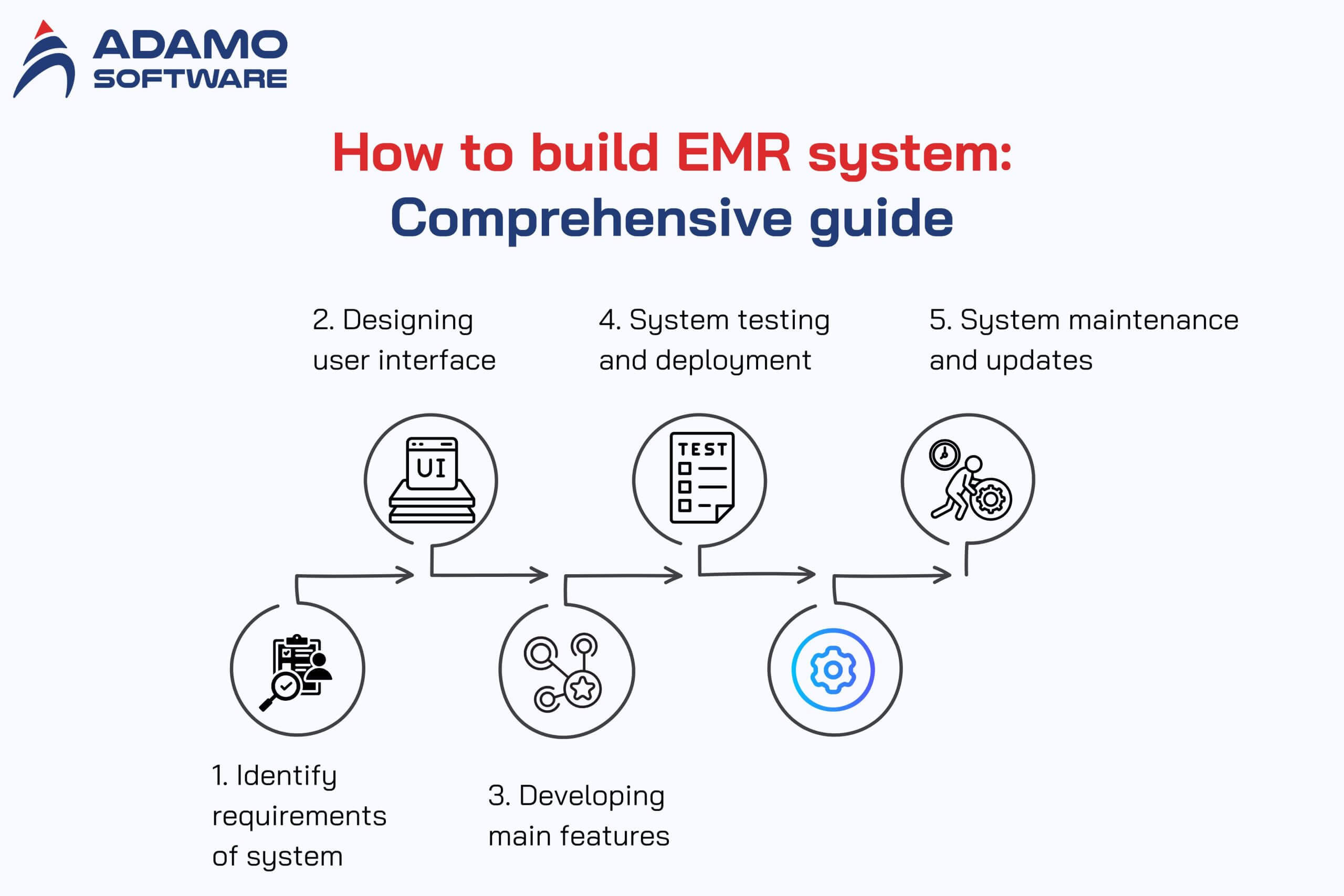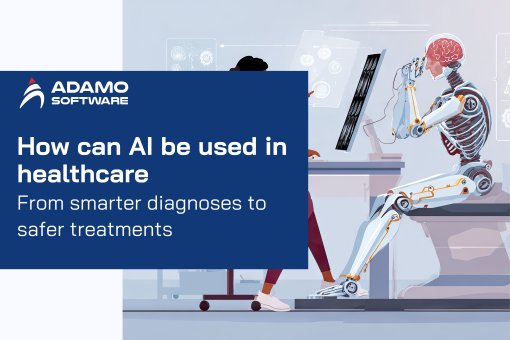How to build an EMR system: A step-by-step guide

EMR, which stands for Electronic Medical Record, is becoming popular in the healthcare industry. EMR refers to medical records that a particular healthcare facility privately owns. It can be a hospital, a polyclinic, or a specialist clinic. Through the EMR system, doctors can use the information collected to diagnose and treat their patients. Comprehensive and accurate documentation of patient medical history, tests, diagnoses, and treatments in the EMR ensures appropriate care across healthcare facility operations. Thanks to the EMR systems, healthcare facilities can optimize patient records management and improve the quality of care. But how to build an EMR system? Let Adamo Software guide you through step by step.
Through this blog post, you will get more insights about the tech stack for how to build an EMR system and the main features needed for creating an ERM system. After getting to know the signs that your business needs to build an EMR system, you will learn each step in how to build an EMR system. All information has been thoroughly researched and updated to the latest trends. So, let’s read our post and find some useful information for you!
I. Tech stacks for how to build an EMR system
Like other systems and software, how to build an ERM system depends on the tech stacks used. Choosing the tech stacks is essential in ensuring security, efficiency, and scalability. Below are some main technology toolkits for building the system.
1. Backend
The backend is the data and infrastructure that makes your application work, which is important in how to build an EMR system. The backend stores and processes application data for your users. To process large and sensitive data in an EMR system, Node.js, Python (Django), and Java (Spring Boot) are ideal tools. These programming languages support security and are extensible, making it easy to customize as the system grows.
2. Frontend
The front end refers to the graphical user interface (GUI) that your users can interact with directly, such as navigation menus, design elements, buttons, images, and graphs. In how to build an EMR system, the front end plays an important role in creating a user-friendly and intuitive interface, helping users access and manage medical data easily.
HTML, CSS, and JavaScript are basic language programs to build simple, interactive, and easy-to-use user interfaces. In addition, Vue.js is also the optimal choice for complex interfaces, helping to simplify the process of building an EMR system and ensure an effective experience.
3. Database
The database plays a key role in how to build an EMR system to process large and complex data. PostgreSQL and MongoDB are top choices for database management systems. While PostgreSQL is suitable for complex data structures, MongoDB is flexible for unstructured data, making it easy to store and manage data when building the system. Both of these tools support large and flexible data management, helping to ensure the integrity and quick retrieval of medical records.
4. Security
Security is among the most important factors in how to build an EMR system. Technologies such as OAuth, JWT (JSON Web Tokens), and SSL/TLS help protect personal information and comply with healthcare security standards in healthcare. HIPAA (Health Insurance Portability and Accountability Act) is one of the standards. The above technologies can meet the stringent requirements in how to build an EMR system securely and reliably.
In general, by combining the above technologies, developers can create an effective EMR system that meets security and scalability requirements while ensuring modern features and customization during development.
You can explore more about What is EMR in Healthcare: Types, Features, Cost here.
II. Main features needed for creating an EMR system
When finding how to build an EMR system, you may want to know some main features needed to ensure the effectiveness and security of the system. Let Adamo Software discuss this in detail.

1.User-friendly interface
User-friendly interface is one of the most important features you need to consider in how to build an EMR system effectively. This feature helps medical staff quickly access, search, and operate the system easily, thereby enhancing work performance and reducing errors during operation. With logically arranged icons, buttons, and toolbars, users can easily find patient records, medical histories, and updated information.
When developing an EMR system, you must ensure that it is compatible with multiple devices, phones, tablets, PC, and laptops. This helps to provide maximum support for doctors, nurses, and medical staff in their daily work. Overall, a user-friendly interface helps to enhance user experience, increase work performance, and minimize errors in the healthcare process.
2. Patient record management
How to build an EMR system does not completely depend on one feature. However, when building an EMR system, you must focus on the patient record management characteristic. This feature allows medical facilities to store, access, and edit patient information handily and securely.
The patient’s comprehensive record includes the patient’s basic information like name, age, address, diagnosis, treatment, and test results. With fast search and retrieval capabilities, doctors and nurses can access accurate information when needed, helping to support more effective treatment decision-making.
3. Integration with other medical systems
When developing an EMR system, you should also look at the system’s ability to integrate with other medical systems. In how to build an EMR system efficiently, this feature helps to create a comprehensive and connected healthcare ecosystem. With this feature, your EMR system can connect and exchange data with other systems of the medical facilities, such as the lab management system, medication management system, and insurance, thereby facilitating the smooth flow of information.
With strong integration capabilities, your EMR system can automatically receive test results from the lab, update drug inventory, and quickly process insurance claims without manual operations. This helps to improve the working process, reduce waiting time and errors in medical information, and bring a seamless experience for doctors and patients.
4. Reports and analytics
Reports and analytics features play a key role in how to build an EMR system productively. This feature allows the system to collect and synthesize data from the patient records automatically. Based on the test results and health indicators, the system will create detailed reports on trends, disease patterns, and treatment effectiveness. With the EMR system’s ability to report and synthesize, doctors can detect public health problems early, evaluate the effectiveness of treatment methods, and optimize care processes.
The in-depth analytics from the system can also help doctors personalize treatment plans for each patient, based on health trends analyzed from previous data. This enhances treatment efficiency and patient satisfaction, creating quality medical services and meeting diverse healthcare needs.
5. Security
How to build an EMR system efficiently without the security feature? You cannot. Security is an essential feature to protect the patient’s sensitive data and comply with health data security regulations. This feature encompasses solutions like data encryption, two-factor authentication (2FA), and access management to ensure that only authorized individuals can access and edit information. Below are some benefits of this feature.
- Protect patient privacy
- Regulatory compliance
- Preventing unauthorized access
- Minimizing damage from cyber attacks
- Building patient trust
In general, the main features above help healthcare facilities optimize healthcare processes and protect medical data. Besides enhancing work efficiency, these features also ensure safety, security, and quality of service for patients and medical staff.
III. Signs that your business needs to build an EMR system
If you are looking at how to build an EMR system, you need to identify the signs that your business needs to build this system. First, let’s look at the EMR system development market, which has been growing robustly recently. At the end of 2024, the market is projected to reach USD 18.82 billion and will grow at a CAGR of 6.20% from 2024 to 2034. By 2034, this market could reach $34.34 billion. This growth is largely driven by the increased adoption of digital solutions by healthcare facilities and supportive government policies in many countries.
Looking at these statistics, how do you feel? Let’s look at these signs to see if you need to build an EMR system.
- There is a growing need for decision-support data to improve patient care and operational efficiency.
- There is a need for secure, easily accessible patient records storage and sharing across healthcare units.
- Pressure to comply with health regulations and supporting policies such as the US healthcare initiatives.
- Difficulty in managing patient records manually or through outdated systems, causing inefficiencies and errors.
Building an EMR system can help optimize workflows and help your business take advantage of opportunities from the growth of the digital healthcare solutions market. So, let’s consider if you need the system and want to know how to build an EMR system.
IV. How to build an EMR system: Comprehensive guide
Implementing an EMR is a strategic, landmark decision for any healthcare facility looking to improve service quality and operational efficiency. With the strong development of the EMR market, investing in building this system not only helps optimize the healthcare process but also brings great benefits in terms of security and patient data management. Below is a detailed guide on how to build an EMR system from the first steps.

1. Identifying the requirements of the system
Identifying the requirements of the system is the first and foremost step in how to build an EMR system effectively. You must analyze current medical examination and treatment processes and identify areas for improvement. Then, let’s evaluate existing IT infrastructure, network system, and equipment capabilities. This helps define important features, such as patient record management, rapid access to medical information, and interoperability between medical units.
After understanding user needs, you must list essential functions such as medical records management, appointment scheduling, prescription processing, patient history tracking, and reporting and analytics tools. You must ensure the system can integrate with other devices and systems in the hospital for efficient data processing.
Protecting patient information is a top priority in how to build an EMR system. Security requirements include data encryption, access management, and ensuring compliance with international healthcare standards such as HIPAA (in the US) or GDPR (in Europe). Additionally, the system also requires the ability to expand following the growing needs of a healthcare facility, including adding new features or expanding the database without disrupting operations.
2. Designing user interface
Designing user interface is an essential step in how to build an EMR system to ensure user-friendliness and ease of use for healthcare professionals. An ideal interface helps users operate easily, increases work efficiency and minimizes data entry errors. When developing the UI/ UX, you must ensure that the interface is not overloaded with too much information and features on one page. Buttons and menus should be clearly arranged so that users can quickly find the information they need.
EMRs are typically used on devices such as desktops, tablets, and sometimes mobile phones. Therefore, you must ensure that the UI/UX design is compatible with a variety of devices so that users can easily access the system wherever they are. Besides, if the EMR system is used in multiple regions or countries, multilingual support will make it easier for users to use the system.
3. Developing the main features
In how to build an EMR system, the core tasks include developing the main features like storing and managing patient records, integration with other systems, etc. These features need to be rigorously programmed and tested to ensure accuracy and security. Once you have identified the requirements, you must divide the features into independent modules like patient records management, prescription processing, and appointment management. This makes it easy to focus on developing each module without affecting other features.
4. System testing and deployment
After finishing developing the main features, you will come to the next step of how to build an EMR system. By comprehensively testing the system, you can ensure that the systems are working properly without errors. After completing the testing, let’s deploy the system in medical facilities and provide a user manual to the staff to quickly familiarize them with the system. Below are some stages of testing.
- Unit testing
Each small module is tested independently to ensure each function works correctly. Use tools like JUnit or Jest to automate this process, ensuring the accuracy and consistency of each piece of code.
- Integration testing
Combine modules to ensure they work together smoothly. Features like patient records management and appointment scheduling require thorough integration testing because they share data.
- Security testing
This is a necessary step for an EMR system to ensure that patient data is securely protected. Apply penetration testing and data encryption to ensure that the system has no security vulnerabilities.
5. System maintenance and updates
System maintenance and updates is the last step in how to build an EMR system effectively. This helps keep the EMR system stable, updated with new features, and ensures data security in the context of increasingly complex cybersecurity threats. This step involves performing periodic testing to ensure that modules are operating properly and without any unusual issues. Besides, performance testing and data consistency testing are also a part of system maintenance and updates.
Besides regular maintenance, you must update the operating system, database software, and EMR system components with the latest security patches to prevent security risks. Based on user feedback and the evolving needs of the organization, let’s add new features or improve existing ones.
In the event of a failure, there must be a process in place to restore data and return the system to a normal state. This may include using backups and redeploying affected components. In addition, you must plan and document in detail the maintenance procedures and updates performed, allowing for tracking and evaluating the effectiveness of system maintenance.
In general, fully developing these features makes the EMR work efficiently ensure compliance with safety and security standards in the healthcare industry. If you are finding how to build an EMR system, you must take the above step-by-step guides.
V. How Adamo can be your partner for EMR system development
With the huge challenges of technical and security requirements, choosing a reputable partner to develop an EMR system is extremely important. As one of the leading companies in technology in Vietnam, Adamo Software can be your choice with rich experience in how to build an EMR system. Let’s see how Adamo can be your digital health solutions partner for EMR system development.

1. Extensive expertise
Adamo Software has many years of experience in the field of medical software development, from EMR systems to smart medical support applications. Adamo’s team of experts not only has solid knowledge of technology but also has a deep understanding of legal requirements and medical security standards, helping your EMR system comply with international regulations such as HIPAA and GDPR. So, how to build an EMR system efficiently is no longer a difficult question.
2. Flexible customized solutions
Every medical facility has different needs and workflows. Adamo is committed to providing EMR solutions that are customized to each specific requirement, from user-friendly interfaces to advanced features such as appointment management and treatment tracking. Adamo’s development team will work closely with you to understand your needs and build an effective EMR system that fits your organization’s operational processes.
3. Integrating advanced technology
Adamo Software applies the latest technologies such as artificial intelligence (AI) and machine learning (ML) to EMR systems. This helps to enhance efficiency and automate many complex tasks. Besides, Adamo ensures the scalability of the system, helping you easily meet future growth needs.
4. Ongoing support and maintenance services
After deployment, Adamo Software is committed to providing ongoing system support and maintenance services, ensuring your EMR system always operates stably and securely. The technical team is ready to respond quickly, support troubleshooting and update new versions to meet the changing needs of the modern medical environment.
Still hesitating to choose Adamo Software for your EMR system? Let’s contact our team for a more detailed consultant.











